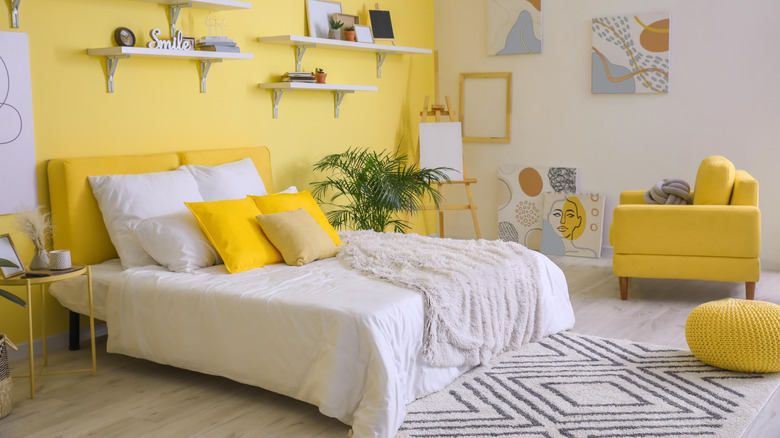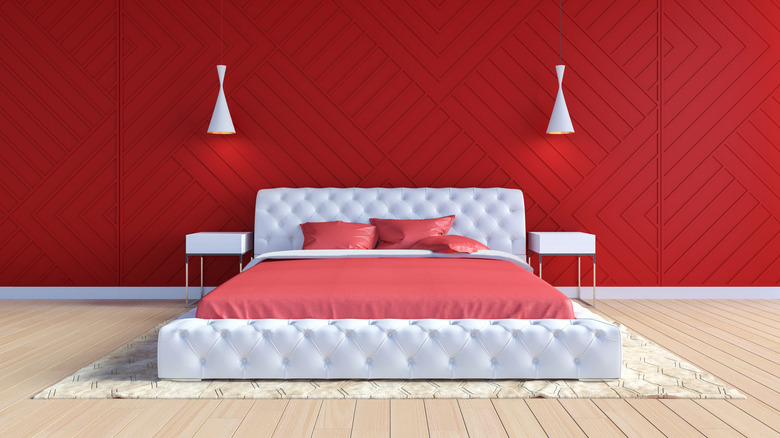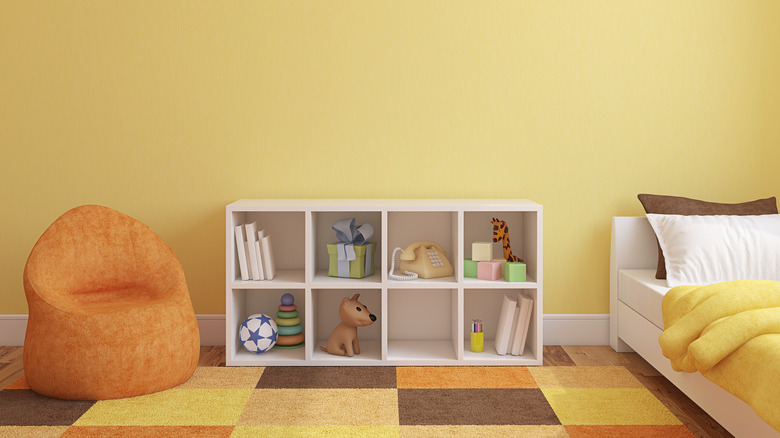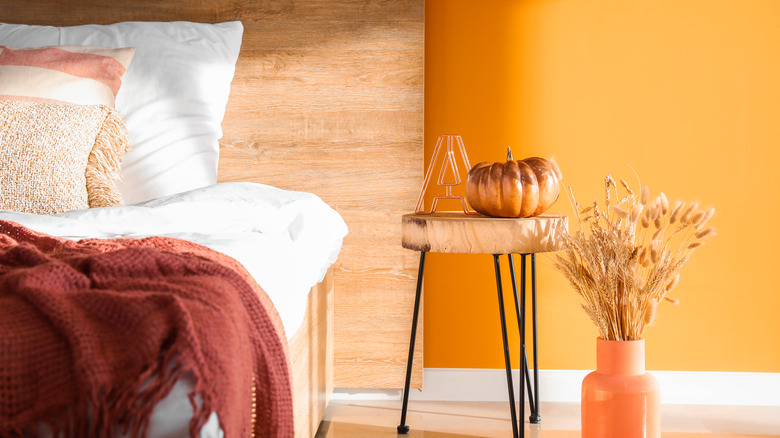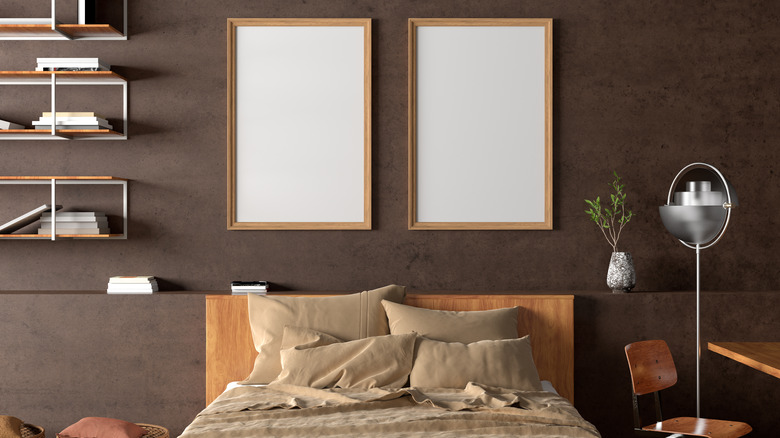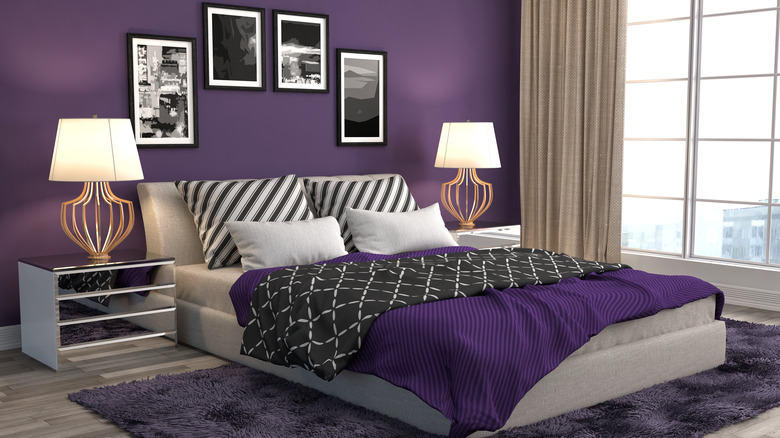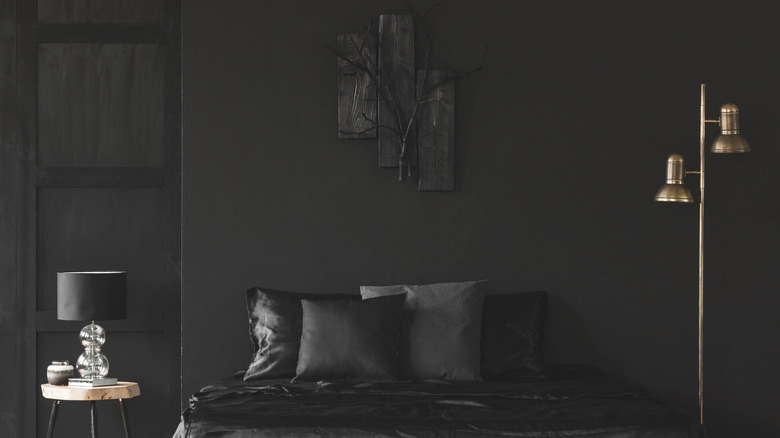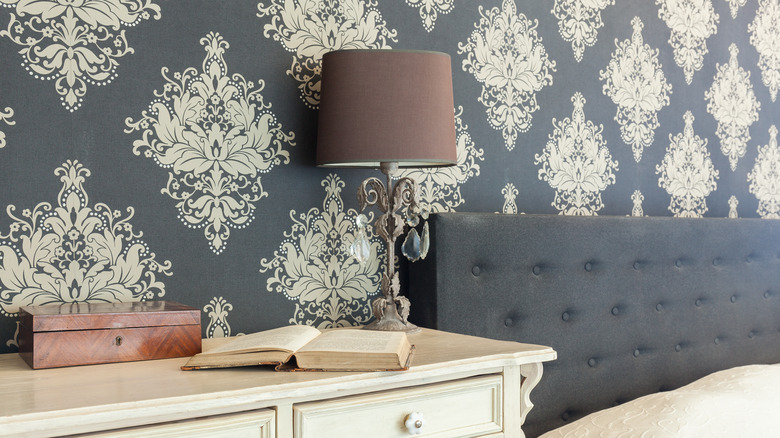6 Colors You Should Steer Clear Of In Your Bedroom
Your bedroom is a source of comfort in your home, where you can relax after a hard day, recuperate when you're sick, or engage in your favorite activities in your free time. These rooms in your house should provide a calming energy that allows you to unwind, turn off your brain and get ready for bed every night. Surprisingly, many of the colors featured in bedrooms nowadays do the exact opposite, leaving their occupants in psychological disarray and repeatedly keeping them from receiving a good night's rest.
It has become commonplace to watch interior designers on reality television shows paint bedrooms funky colors as a way to revamp a home. While these flashy colors may seem appealing at first glance, Healthline and Color Psychology state that they could negatively affect your physical, mental, or emotional health and well-being. If you want to redesign your bedroom but are still on the fence about the aesthetic you're going for, here are six colors you should avoid incorporating into your bedroom's décor.
Red could have you on edge
A common consensus across expert opinions is that including shades of red in your bedroom is a bad idea. According to Octane Seating, red is one of the three primary warm colors located on the color wheel, which can evoke feelings of anger and intense passion within a person upon looking at it. Color Psychology says that red also increases a person's respiratory rate, raises blood pressure, and boosts metabolism, speeding up bodily functions and making it challenging to lull off to sleep. Red is also commonly used to signify danger, which can spark a rush of adrenaline in humans and make sleeping harder.
You may think: Red is also the most often associated with romance. Wouldn't that make the color an appropriate choice for a bedroom? Octane Seating disagrees. Red walls or an onslaught of red décor pieces can induce sexual overdrive, which could lead to frustration between romantic partners. However, when used sparingly, red can complement a bedroom nicely, adding a sophisticated warmth to a commonly used space in your home.
Yellow could bring you down
Yellow bedrooms were all the rage in the late 20th century, according to Retro Planet, and pops of this bright color are still familiar inside bedrooms of the present. However, too much yellow may wreck an individual's overall mood and sleep patterns. Yellow is another warm color on the color wheel, states Octane Seating. Although it doesn't affect the human mind nearly as much as the color red, yellow can still evoke negative emotions, making it another poor choice for a bedroom. The color yellow also stimulates the brain, rendering it challenging to go to sleep as a result.
Yellow is much better suited inside a study room or home office, per Octane Seating, where a resident needs to be awake and alert to accomplish everyday tasks. For those incredibly draining days spent working or studying, a yellow office can boost the spirits of its occupant while also motivating them to finish the work they've started. Still, avoid using too much yellow, as this could spark feelings of anxiety within a person using the room for long periods.
Orange will keep your mind active
Rounding out the warm color trio is orange, the secondary color created when mixing red and yellow. Color theorists frown upon using orange in the bedroom for the same reasons as its neighbors on the color wheel: It elicits feelings of excitement rather than inducing relaxation. Color Psychology states that orange is a social color, and those who aren't fond of it tend to be quiet and introverted. Because the color is a combination of red and yellow, orange provides the passion associated with red alongside the happiness and energy associated with yellow.
Orange also is the color of enthusiasm, creativity, and stimulation, says Color Psychology. Incorporating too much orange into your bedroom's décor may keep your mind preoccupied at night, given the shade's brightness and call to wake up and be creative. This color, like yellow, is much better suited inside an office, or another location in your home where mental alertness is encouraged, says Octane Seating.
Dark brown prevents relaxation
You'd be mistaken if you thought the list of bedroom no-gos was limited to vibrant colors. Even darker and more neutral colors can make poor additions to a bedroom unless implemented in moderation. Octane Seating says that shades of dark brown in a bedroom are associated with dullness, which prevents people from relaxing and going to sleep easily. Healthline also states that dark brown walls negatively impact sleep patterns, as the color instills feelings of uncertainty capable of keeping people awake at night.
If you're adamant about incorporating a neutral brown into your bedroom's color scheme, there are ways to do so while prioritizing your mental and physical health. Amerisleep recommends using shades of brown mixed with tones of orange, which emit a calmer vibe than darker chocolate browns. Darker colors can also make a room feel cramped and tiny, leading some interior designers to advocate for a lighter hue bedroom furniture, as well as walls and accents. Upgraded Home says to consider the size of your room before deciding on a color scheme to decorate with.
Purple could keep you up all night
Despite being one of the cooler colors on the wheel, purple is one of the worst colors that a homeowner could add to their bedroom, says Terry Cralle. The color purple encourages the imagination to stir, which, similarly to the other colors mentioned, can make it more challenging to drift off to sleep. As the human imagination stirs, dreams and nightmares can become too intense to stay asleep, causing people to jolt awake frequently and receive a poor night's sleep overall.
Lavender, on the other hand, a much lighter shade of purple, is encouraged inside bedrooms since it emits a relaxing vibe that calms an individual's nerves and prepares them for bed, says Signature Exteriors. The smell of lavender is also scientifically proven to help people go to sleep. The lavender plant is an herb commonly used in room deodorizers, body washes, and lotions to soothe and wind down the body, thus preparing for a good night's rest.
Black can suck out the energy
While painting walls black isn't a trendy design choice, black home décor is admired and never goes out of style. However, maybe keep the black to a minimum in your bedroom. According to mattress company Casper, black can trigger negative emotions in people when looking at it, particularly sadness, anger, and fear. Black can also remind people of death, says Casper, which might not be the best topic to consider when trying to sleep.
In feng shui, the traditional Chinese practice used for interior design, black is thought to absorb significant amounts of energy from a space, just as black absorbs light and all colors of the spectrum, says Farm Food Family. Depriving a living area of all negative and positive energies is considered harmful, as feng shui's purpose is to create well-balanced and harmonious energy in a living space to enhance an individual's chi. However, this doesn't mean the color can't ever be used inside a bedroom. Farm Food Family recommends incorporating black into a sleeping space in small amounts through the use of accessories.
Jenny Marrs agrees
The aforementioned shades aren't the only examples of bright and loud hues to steer clear of in the bedroom. HGTV design star Jenny Marrs says she abstains from using bold colors entirely when designing a bedroom, opting for more soothing shades, like neutrals and creams. "I love to have fun with design, but I really avoid loud paint colors and patterns in the bedroom because I want to promote a calming sensation the minute you walk into the room," she told Homes & Gardens.
Shades associated with energy and social interaction are a no-go for a room designated for sleep and relaxation. Marrs says such colors are great for other parts of the home, however. As for dark shades, Marrs says they're inappropriate for a bedroom due to their tendency to hold heat and make a space feel cramped, as packed rooms and toasty temperatures can easily interfere with people's sleep patterns.
Of course, how you design your bedroom is personal — but it couldn't hurt to try out some of these tips, right?
